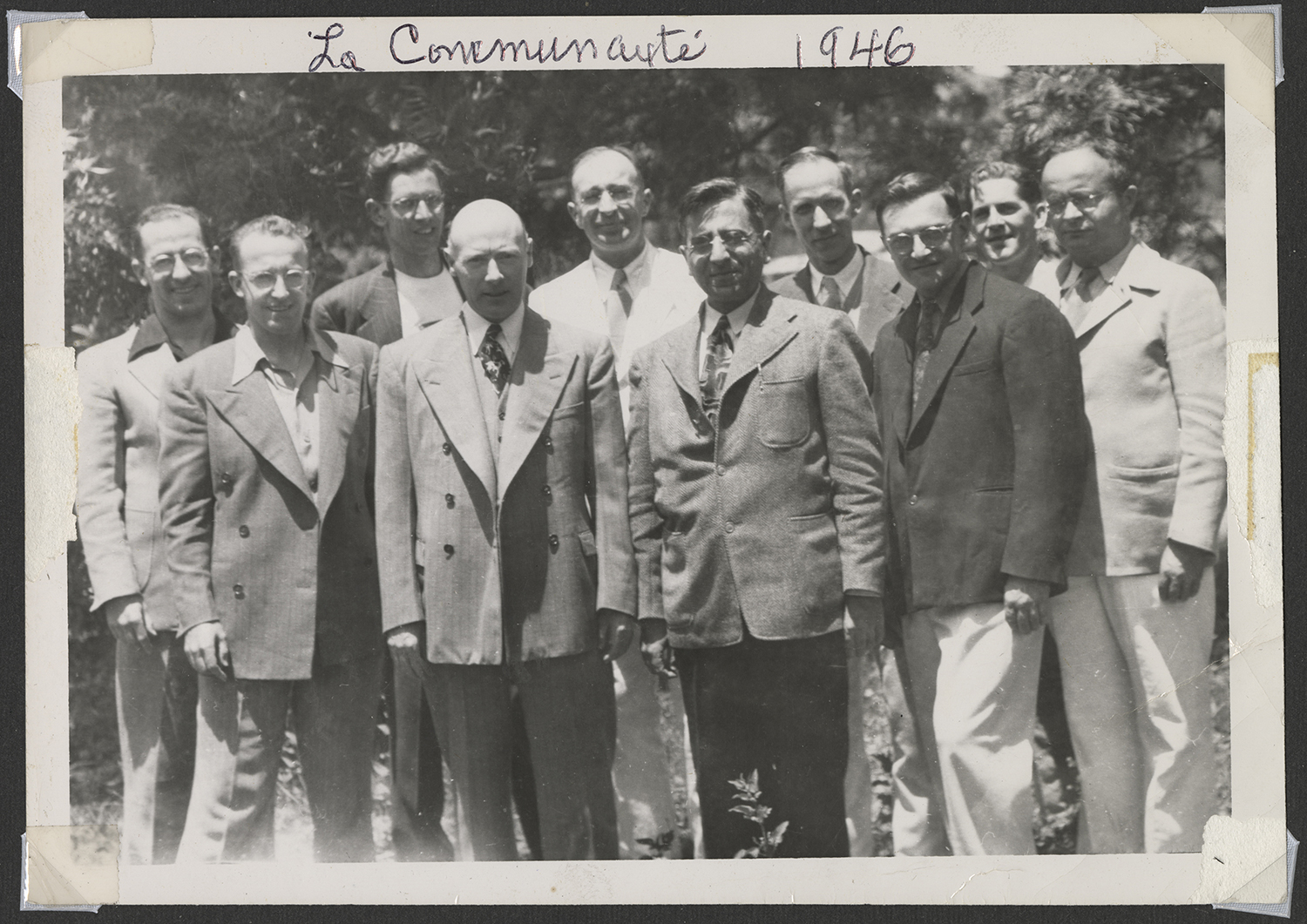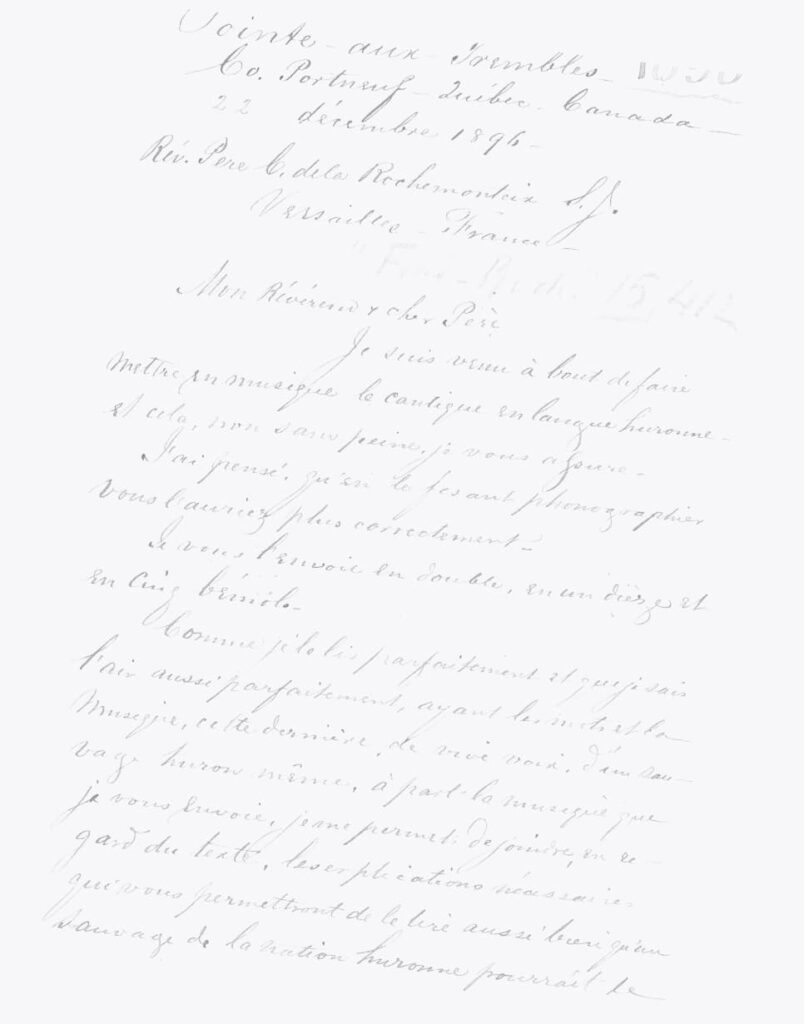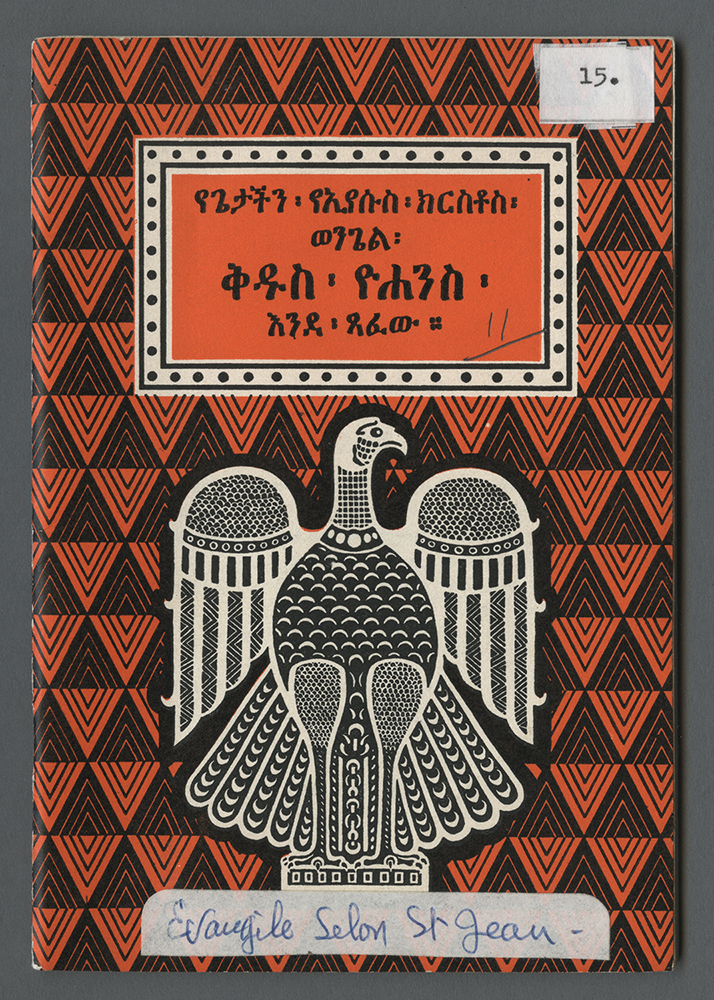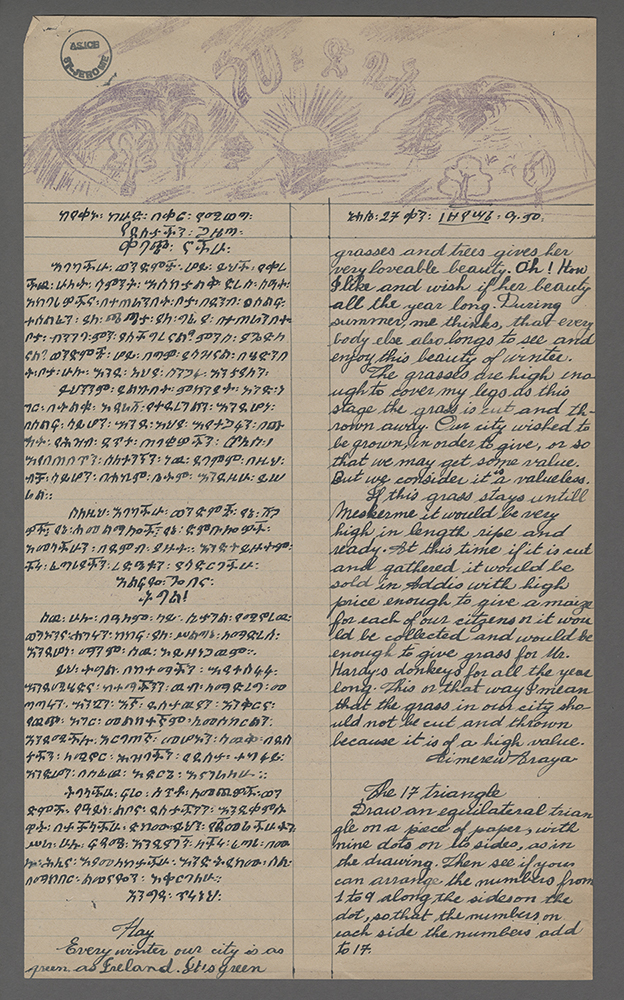Teachers, philosophers, scientists
The Jesuits of Canada in Ethiopia
As the 1945 school year was about to begin, four Jesuits travelled from Canada to Addis Ababa at the invitation of Ethiopian Emperor Haile Selassie I. Mandated with the reorganization of the country’s educational system without engaging in proselytizing, these Jesuits were dressed in civilian clothes.
First assigned at Tafari Makonnen School, the Canadian Jesuits on Ethiopian soil expanded their field of work to include positions in educational institutions at all levels, scientific and academic research, and various pastoral ministries, including the Jesuit Refugee Service.
The Archive of the Jesuits in Canada holds a large collection of textual, photographic, audio and audiovisual records documenting the presence of Jesuits of Canada in Ethiopia over the course of the twentieth century.

Exhibition Modules
Tafari Makonnen School
Upon arriving in Addis Ababa in the late summer of 1945, the Jesuits tackled the first task assigned to them by Emperor Haile Selassie: reorganizing Tafari Makonnen primary school in time for the start of the new academic year. In the years that followed, they added a secondary curriculum to the institution, and set up courses and activities promoting the development of well-rounded individuals, such as team sports, theatre, and scouting.
According to the tradition of Jesuit colleges, sports and athletics were organised to complete the education of the child. ‘Mens sana in corpore sano!’
Les Jésuites et l’éducation en Éthiopie de 1945 à 1950, by Édouard Trudeau, S.J., Master of Education thesis, Boston College, July 1953.
The "Canadian Gentlemen"
CLAUDE SUMNER, S.J.
Following his literature and philosophy studies in Montreal, Father Claude Sumner’s desire to work as a missionary became a reality: he was sent to Ethiopia and, in 1953, started teaching philosophy at University College Addis Ababa (UCAA).
Father Sumner distinguished himself throughout his career at UCAA (later Addis Ababa University) where he taught until 2001. His research work brought to the fore relatively unknown philosophical texts originally written in Ge’ez and Amharic, thus contributing to knowledge of traditional Ethiopian philosophy through works such as Ethiopian Philosophy and Classical Ethiopian Philosophy. He eventually headed the university’s Philosophy Department and organized numerous conferences. The Kenyan philosopher Henry Odera Oruka, who was his colleague, believed that Father Sumner’s contributions went far beyond his academic publications: he was instrumental in creating a genuine community of African scholars.
LUCIEN MATTE, S.J.
Originally from Quebec City, Lucien Matte, S.J. developed an interest in sciences and technology at an early age, and entered the Jesuit novitiate in Sault-au-Récollet in 1930. Although he had been appointed Rector of Quebec City’s Collège des Jésuites early in his priestly life at the age of 35, he was longing to serve in overseas missions.
When the Superior of the Jesuit Province of French Canada needed to appoint a Superior for the new educational project in Ethiopia, Lucien Matte’s leadership and administrative talents made him the perfect candidate. In 1945, Father Matte became the first Superior of the Jesuits of Canada in Ethiopia.
Over the following 17 years, Father Matte helped transform a school that was struggling to recover from the Italian invasion into an institution boasting a number of secondary curricula and extracurricular programs. His crowning contribution, however, was as a key player in the founding and early years of Ethiopia’s first university, University College Addis Ababa, which he served as the first President. In doing so, he fulfilled the instructions given by Saint Ignatius Loyola to Jesuit missionaries traveling to Ethiopia in 1555: “Thought should be given to eventually setting up universities or institutions of higher learning.”
In 1986, the Ethiopian educational project initially headed by Lucien Matte led to the creation of the independent Jesuit Province of East Africa, which still today brings together Jesuits from Tanzania, Uganda, Sudan, South Sudan, Kenya, and Ethiopia.
MARCEL CHARPENTIER, S.J.
Nicknamed Charpy, Brother Marcel Charpentier, S.J. arrived in Ethiopia in 1946. Following delays in procuring materials and setting up workshop spaces, he completed training as a handicraft instructor in Quebec City, and finally opened his workshop to Tafari Makonnen School (TMS) students in 1949. The handicraft section taught skills in woodworking, leatherworking, metalworking and bookbinding.
Brother Charpentier’s teaching career at Tafari Makonnen School spanned the various periods of the Canadian Jesuits’ presence in Ethiopia, from the auspicious beginnings of 1945 to their departure from TMS during a period of political uncertainty in the 1970s. Having returned to Canada in 1975, Brother Charpentier left diaries and audio cassette tapes documenting his time in Addis Ababa and illustrating the Jesuits’ educational project in Ethiopia.
University College Addis Ababa (UCAA)
Founded in 1950 under the direction of Lucien Matte, S.J., University College Addis Ababa (UCAA) awarded degrees to its first graduating class in 1954. UCAA began as a Jesuit-run institution, but quickly grew into a more diversified project. The faculty composed of Jesuits and lay professors from various countries was soon joined by Ethiopian graduates taking up teaching positions. In 1961, UCAA merged with other colleges to form Haile Selassie I University. Renamed Addis Ababa University in 1975, it remains Ethiopia’s oldest higher education institution.
Thought should be given to eventually setting up universities or institutions of higher learning.
Ignatius of Loyola to João Nunes Barreto, patriarch of Ethiopia, Rome, 1555
A sonic landscape of Ethiopia
Thanks to the growing availability of sound recording technologies in the second half of the 20th century, the Canadian Jesuits were able to produce numerous recordings on discs, reel-to-reel tapes and cassettes documenting their presence in Ethiopia, thus capturing a “sonic landscape” of their lives in Addis Ababa.
These audio materials feature recordings of Ethiopian and East African music, including works performed in concert by Tafari Makonnen School students. Also preserved are oral histories and anecdotes recorded by Jesuit educators wishing to share their Ethiopian experiences with relatives and friends who had not had the opportunity to visit that country.
Music recording, Tafari Makonnen School. [195-?]. 0900-0022.7.17.A
Music recording, Tafari Makonnen School. [195-?]. 0900-0022.7.17.A
Music recording, Tafari Makonnen School. [195-?]. 0900-0022.7.20.A
Music recording, Tafari Makonnen School. [195-?]. 0900-0022.7.20.A
Music recording, Tafari Makonnen School. [195-?]. 0900-0022.7.21
The Amharic Language
The Jesuit missionaries of past centuries are known for their keen interest in local languages. In keeping with this tradition, the Canadian Jesuits who lived and worked in Ethiopia during the 20th century studied Amharic, a Semitic language that is widely spoken throughout the country and remains the official language of the Ethiopian government.
Amharic was taught at Tafari Makonnen School by Ethiopian teachers and formed part of daily life at the institution. The school newspaper, the Tafari Makonnen Ensign, printed articles in Amharic alongside articles in English, and students performed plays translated into Amharic, including Molière’s The Miser.
Besides traditional language learning methods, the Canadian Jesuits working in Ethiopia used 20th-century technologies to learn Amharic, and a number of recordings and tapes featuring Amharic vocabulary and texts are preserved at the Archive of the Jesuits in Canada.
List of words and phrases prepared by Claude Sumner, S.J. Speaker: Abba Abraham François, of the Pontificio Collegio Etiopico. Recording: Radio-Vatican. 1950. 0900-0022.7.13.B
"Our Best Ambassadors"
Returning from a State visit to East Africa, a Canadian senator commented in 1970 that “if Canada is known in Ethiopia, it is due to the great popularity of Reverend Father Lucien Matte […] Thanks to him, relations between Canada and Emperor Haile Sélassie remain of the very best.” Jesuit educators, among other Canadian teachers who worked in Ethiopia, played a small, but significant, role in the relations between these two countries.
After serving for twelve years as the first President of University College Addis Ababa, Father Matte returned to Canada in 1962 to take up a new assignment at the helm of the new University of Sudbury. Appreciative of Father Matte’s talents and contributions to Ethiopia’s educational system, Emperor Haile Selassie donated funds towards the building of the University of Sudbury.
By the early 1970s, there were no Jesuit teachers left at Tafari Makonnen School. However, despite the approach of a new political regime in Ethiopia, some Jesuits continued teaching and doing research work at the university level.
The Addis Ababa Geophysical Observatory
by Dominique Robb, Young Canada Works intern 2020-2021
Associated with University College Addis Ababa (UCAA), the Geophysical Observatory of Addis Ababa was founded in 1957 – just in time to participate in the International Geophysical Year. By 1962, it was designated as a Worldwide Standard Seismic Station.
The Observatory’s most distinctive feature is its location at the junction of three active faults (the Ethiopian Rift, the Red Sea Rift and the Aden Gulf Rift), which is ideal for the study of seismology and geomagnetism. Addis Ababa is also situated near the Earth’s magnetic equator.
Research conducted at the Geophysical Observatory led to the drafting of Ethiopia’s first seismic map. It also helped warn the local population of imminent earthquakes and inform the government of the adequate infrastructures to be put in place.
While working at the Observatory, Pierre Gouin, S.J., Émile Cambron, S.J., and their respective teams welcomed numerous civil servants, diplomats and leaders, including Emperor Haile Selassie himself. Such visits confirmed the high level of research being pursued at the Addis Ababa Geophysical Observatory as well as its recognition by the international community.
Pierre Gouin, S.J. was the director of the Addis Ababa Geophysical Observatory from 1957 to 1978. After teaching science at Tafari Makonnen School during his Jesuit formation, he returned to Addis Ababa in 1954 to join the faculty at University College Addis Ababa, where he taught geophysics and physics. From 1957 to 1978, he divided his time between teaching and managing the Observatory. His work in Ethiopia culminated with the publication of his book Earthquake History of Ethiopia and the Horn of Africa in 1979.
Father Gouin received many awards and honours from Emperor Haile Selassie for his work developing a seismic map of Ethiopia in 1976 and the research he directed at the Observatory, including a certificate of recognition in 1973.
Émile Cambron, S.J. worked at the Addis Ababa Geophysical Observatory from 1957 to 1972. During his Jesuit formation, he studied astronomy and physics at the University of Montreal. After teaching physics and mathematics for 23 years at Collège Sainte-Marie in Montreal, he joined the Canadian Jesuits in Addis Ababa in 1957. He taught physics and supervised the science laboratory at University College Addis Ababa for 15 years. In 1959, Father Cambron was named Associate Director of the Astronomy Observatory and, in 1967, Professor of Astronomy.





















































